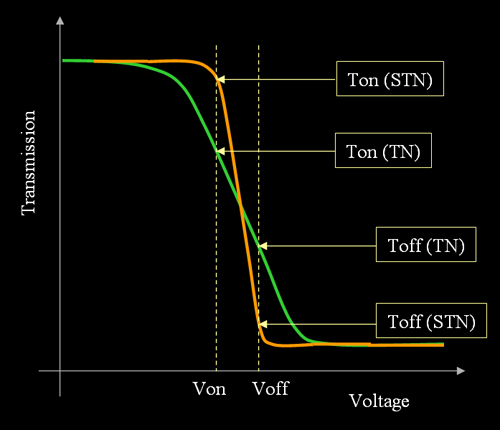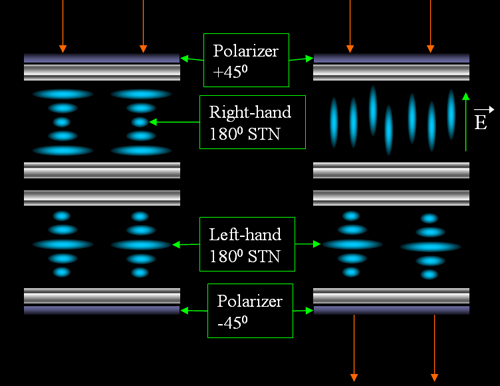°°
[Super Twisted
Nematic (STN) mode]
When the requirement for displaying high
information content is present, the number of pixels becomes
increasingly large and it is not possible to address a single each
pixel. This led to the matrix addressing in which an array of M x N
pixels is driven by apply pulses to the M rows and N columns. This
significantly reduce the number of electric interconnects to the
external driving ICs. For example, for a 150X150 pixel LCD, only
needs 150+150=300 connects for matrix driving, instead of
150x150=22,500. Such scheme which scan one row at a time is called
multiplexing. The TN mode is limited to about 10 rows of pixels
because of the moderate transmission-voltage curve.
In order to have more rows to address for high
resolution LCD, steeper t-v curve is required based on the Alt-Pleshko
law, shown in equation below:

where N is the maximum addressing rows. Von
and Voff are the voltages for the black and bright state
respectively.
In the early 1980's, Nehring and Scheffer,
using computer simulations, came up with the super twisted nematic
liquid crystal (STN) which has a twist of over 180°„, typically
between 210°„ and 270°„, its t-v curve is much steeper than the 900
TN, resulting larger number of addressable rows for multiplexing.
Figure 1 shows a t-v curve comparison between TN and STN modes.

Figure 1. Contrast ratio (Ton/Toff) comparison between TN and STN.
With the steeper t-v response, it is possible to achieve higher
contrast with the same voltage selection ratio (Von/Voff).
Therefore, the multiplexity is greatly enhanced.
Another important parameter
which affects the steepness of the t-v curve is the pretilt angle at the
surface.
However, the STN intends to produce blue and yellow images
because of its spectral peak at yellow and blue wavelength,
instead of black and white; this causes problems to produce color display. The
solution lies in stacking two STN films with opposite handiness of
twist, and it is called Double STN (DSTN) as shown in figure 2. As a result, a black and
white display can be achieved, with implementing the color filters,
a full color LCD is possible.

Figure 2. A schematic illustration of a double STN display.
Further Readings
and References:
T. J. Scheffer and J. Nehring, "Investigation
of the electro-optical properties of 270°„chiral nematic layers in
the birefringence mode", J. Appl. Phys. Vol. 58,
3022 (1985).
T. J. Scheffer and J. Nehring,
"SUPERTWISTED NEMATIC (STN) LIQUID CRYSTAL DISPLAYS", Annu. Rev. Mater. Sci.
1997. 27:555®C83
P. M. Alt and P. Pleshko, "Scanning
limitations of liquid crystal displays", IEEE Trans. Electron
Devices, Vol. ED-21, No. 2, 146 (1974).
°°